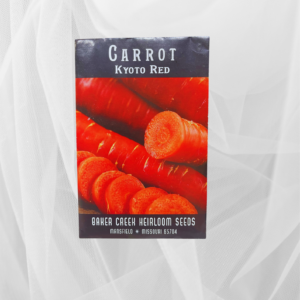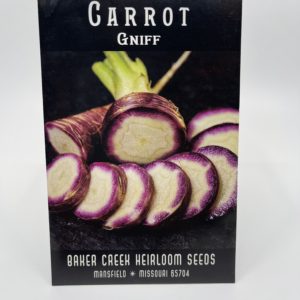Deep Purple Coated
1,750 د.ك
The very straight, tapered roots of Deep Purple carrot grow 17-20cm (7-8”) long. These carrots are named for the fact that the purple characteristic runs right to the core, and they keep their colour when lightly cooked. The tops are strong for easy harvests, and the storage potential is great. This is a fine fall harvest carrot that is good for juicing and it looks amazing in salads. The sweet, smooth-skinned roots were a staff favourite from our field trials. This is a high yielding, very uniform variety for the market grower or home gardener.
These seeds are coated with an inert, organically certified layer which helps to minimize clumping in storage and seed sowing machines. The coating is approved by organic certifiers in Canada, the US, EU, and Japan.
Matures in 75 days. (Hybrid seeds)
All carrots can be harvested immature as baby roots, which tend to be crunchy but tender, and quite sweet. They can also be left to reach their full size, shape, and colour, of course. All carrots are high in beta-carotene, a pigment that we metabolize as vitamin A. A lack of vitamin A can result in poor vision, hence the notion that carrots are good for eyesight. Carrots are also rich in Vitamins C, B6, and Niacin.
The first main trick with carrot seeds is to sow them shallowly and then maintain moisture in that top layer of soil until they germinate. Because they may take as long as three weeks to germinate, this can be challenging, especially in hot weather or in exposed, windy gardens. The way to achieve this is to water very deeply prior to planting, and then either water very regularly or employ some other means to reduce evaporation. Some growers like to use lightweight row cover, which helps to maintain moisture and has the added benefit of keeping away the carrot rust fly. But we’ve also seen some growers simply lay a 2×4 beam, or even plywood, over the damp seedbed. This is lifted every few days to check on progress, and then removed at germination.
If you have the luxury of growing carrots without the presence of carrot rust flies, you may still be concerned with soil dwelling insects such as wireworms, which seem to be true lovers of carrots. They are so attracted to carrots, in fact, that a full-grown carrot makes a very good lure for wireworms. Just bury carrots or carrot pieces in several areas around the intended seedbed, and mark where you bury them. If wireworms are present, you can then dig up the carrot pieces and easily remove the wireworms from the bed, or at least go a long way to reducing their population.
Take extra care with the carrot bed to insure that the soil is loose and completely free of stones or other debris. Truly beautiful carrots are easy to grow if the extra time is taken to produce a good home for them. Avoid nitrogen-heavy fertilizers and manure that has not been composted for more than a year, as you may end up with big, bushy tops on pitiful, spindly roots.
Because carrot seeds are tiny, they need to be sown shallowly. The trick is to keep the top-most layer of soil damp during the relatively long germination period. Water deeply prior to planting. Direct sow the tiny seeds 5mm (¼”) deep, 4 seeds per 2cm (1″), and firm soil lightly after seeding. Make sure the seeds are only just buried. Water the area with the gentlest stream possible, and keep it constantly moist until the seeds sprout.
Growing
Ideal pH: 6.0-6.8. The softer and more humus-based the soil, the better. When soil is dry enough in spring, work it to a fine texture. Broadcast and dig in ½ cup complete organic fertilizer for every 3m (10′) of row. Avoid fresh manure. Carrots will become misshapen, but still edible if they hit anything hard as they grow down into the soil. Keep weeded and watered.
غير متوفر في المخزون








